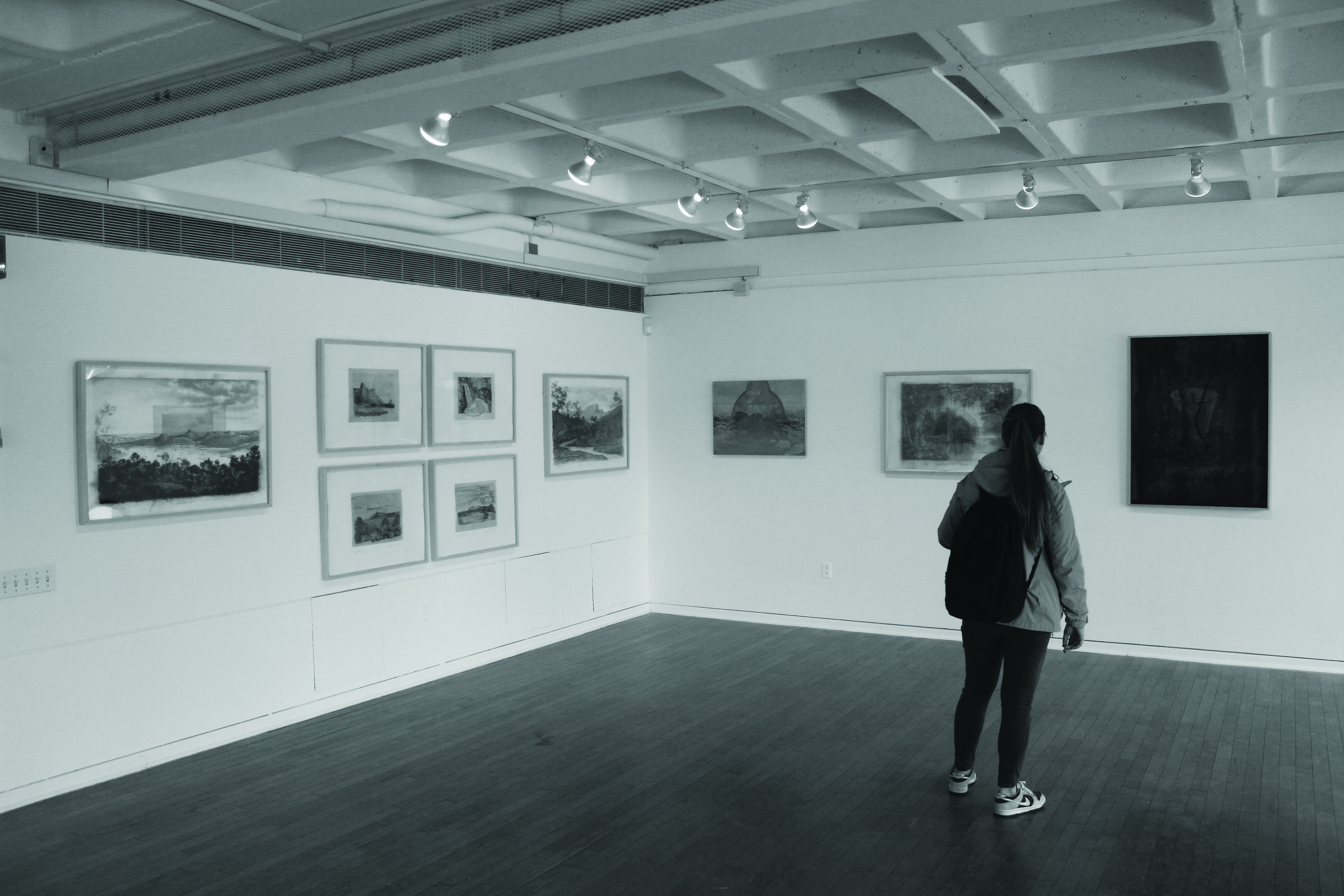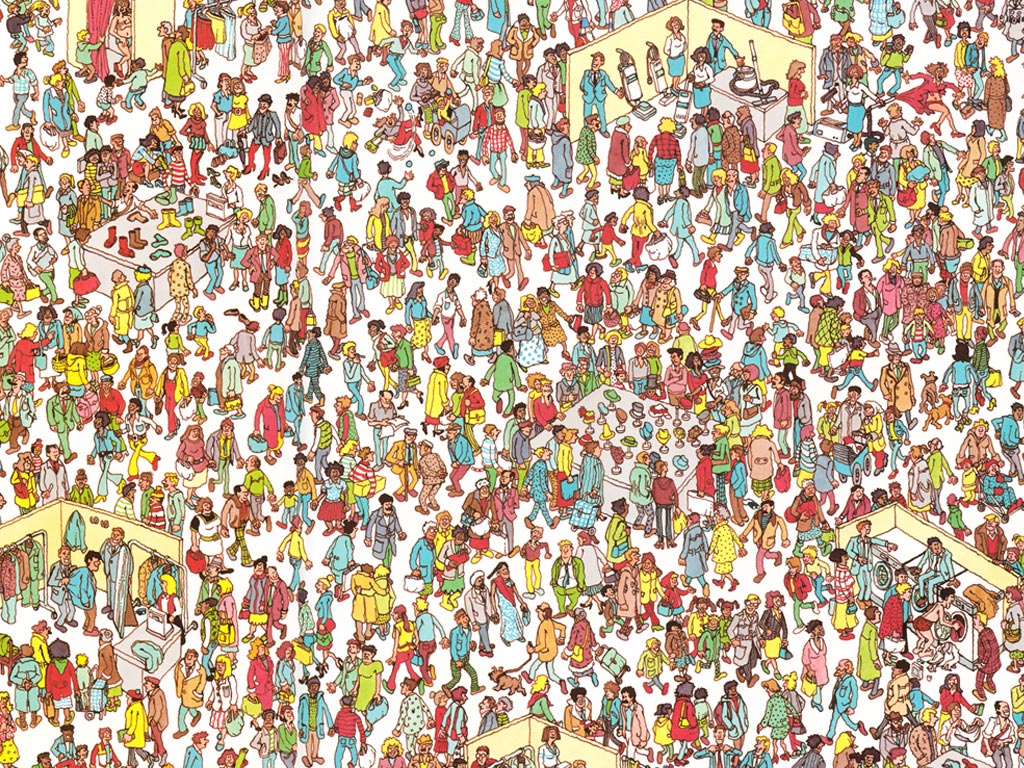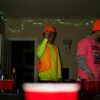Entering Cummings, the skeleton of a Ford Explorer looms above the gallery space, perched atop slices of wood. A curving, silver slide extends from the front bumper down to the floor. A work in progress, this functional sculpture is part of the faculty exhibition Towards a New Reality: Greg Bailey and Timothy McDowell, a show that subtly reflects on the themes of climate change, alternative models of reality and humans’ interactions with nature.
While the form of their artwork is very different, both Bailey and McDowell, Professors of Studio Art, are interested in the ways that humans interact with the earth, and how our relationship to the planet has drastically changed over time.
The artists often discuss how indigenous people of North America had a stronger connection to their environment and lived in a radically different manner than we do. Now, American culture and society have caused humans to live with “a big separation from the natural earth,” according to Bailey. This separation has led to an unsustainable lifestyle and a continuously changing relationship to time.
We now expect to live at a faster and faster pace, aided by the ability to transport ourselves and to transport knowledge at unprecedented speeds. For Bailey, this lifestyle and culture is unsustainable. “Now we’re fighting really, really hard to preserve this way of life, and I think that model of reality is going to change. Capitalism is essentially built on infinite growth, and we live on a finite planet” he said. Change is imminent.
Thus, as the show’s title implies, humans must be always looking toward a new reality as the planet continuously evolves, accelerated by the actions of humans. “The overall premise of the show is our response to things changing, and that kind of perception of ‘reality’ versus what a real ‘reality’ is. I personally don’t believe that humans ever get to the real reality, we just have flexible models of reality that just keep being adjusted, and sometimes they’re further off than others,” said Bailey. Using metals, wood, found objects, and leftover materials, Bailey’s sculpture ranges from a simple form — a polished rock — to a highly unique playhouse for his daughter.
His rock pieces, beautiful polished stones ranging from a striated gray to an obsidian black, are in fact rocks that he found in his yard as he hit them with his lawnmower. He polished them, leaving some natural texture. For Bailey, using these rocks forms a type of connection between humans and nature, “but only from a humanistic point of view.” They would never have become polished through a natural process, but “by polishing them I’m almost bringing them into human time,” Bailey said.
Bailey’s sculptural pieces also incorporate functional elements, such as heat exchangers designed to maximize heating efficiency, solar panels, and Playhouse, built out of Bailey’s old Ford Explorer and trees that fell down in his yard during Hurricane Sandy. Playhouse incorporates meditation on extreme weather events’ effect on humans and the waste that humans produce when consumer items get discarded. However, it is also, in function, a playhouse. Bailey said it is now more of a sculpture of a playhouse, but it will have a second life in his yard as a completed playhouse for his daughter, which he hopes she will enjoy.
In contrast to his recent work, Bailey’s sculpture Self Portrait with Food (2011) presents a jarring view of the artist’s dead, cannibalized body. Bailey was inspired by a hypothetical crisis in which no food is available in the grocery stores, and everyone is fending for themselves. While hunting to feed his family, another hunter finds him, shoots him in the head and takes meat off his body for his own family. This extreme scenario is an alternate reality, a potential occurrence, depending on the course of the future.
Regardless of the content or form, Bailey said his work is from “a personal point of view. It’s based on my desire for security and my interpretation of the things I’m seeing around me.”
McDowell’s primarily two-dimensional work also explores possible visions of the future, environmental change, and his own interpretations of “reality.” By portraying manmade and fictitious landscapes, his work challenges our ideas of the earth.
A set of four digitally rendered landscapes, titled Imagined Landscape #1, #2, #3 and #4, show a variety of fictitious landscapes in dark, slightly ominous tones. In one, the forms of dead tree-like plants sprout up on from dry ground scattered with bushes, set against a cloudy sky. In another, the viewer appears to be looking through a cluster of large plant forms resembling dead, mottled brown and decaying tulips. These works question our understanding of the earth’s landscape using slightly unsettling forms and pairings.
In his series of color etchings, McDowell portrays classically pleasant landscapes in light colors: cliffs, a waterfall, plains and distant mountains. Superimposed on these scenes are brightly colored geometric lines forming a structure over a portion of the landscape. McDowell says these represent the idea of either containing or preserving the land. The works’ titles reflect this dichotomy, for example Preserve/Contain, Sanctuary, and Encase/In-case. It is a future of uncertainty.
Another division is seen in McDowell’s two oil paintings of a bee and a fly, titled Alpha/Omega. For McDowell, these paintings represent the survival tactics of two different species. “The bee is very organized in a colony and a society, with very strict rules of who does what, and the fly is basically every man for himself in terms of survival. Well, the flies flourish fine and the bees are in trouble now because of man’s management of them,” said McDowell. “It’s meant to be like, ‘how naive are we to be in control of the planet, or think we are, and we can do things and correct our problems, when nature is actually in control.”
McDowell and Bailey’s works examine concepts of reality, provoking thought and questioning our current lifestyle and society. However, Bailey stressed that art is a “complicated, imprecise language,” and he hopes that viewers who see the show do not feel they need to take an intellectual approach to art.
Above all, viewers should enjoy looking at the works, thinking about them and interpreting them in their own personal ways. After all, everyone has their own unique experiences of reality, and their own ideas about what the future will bring.










